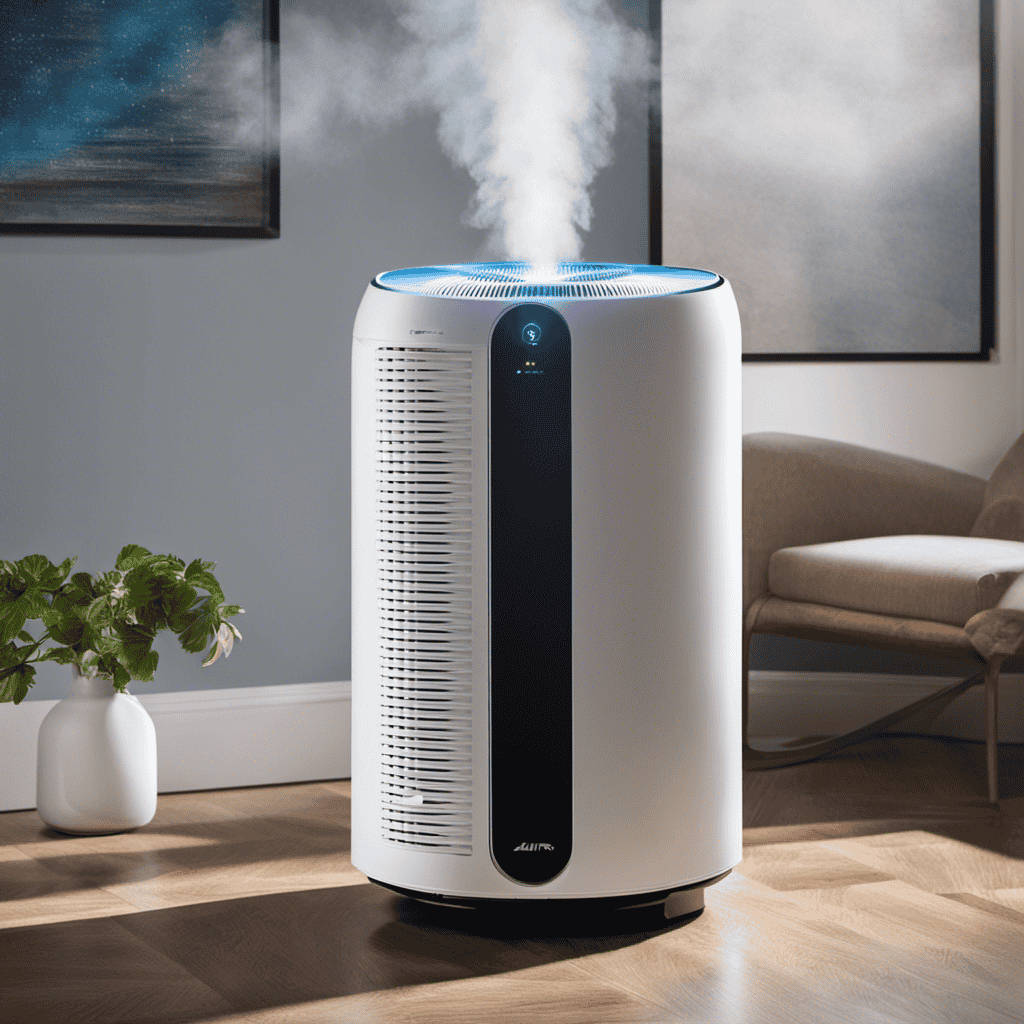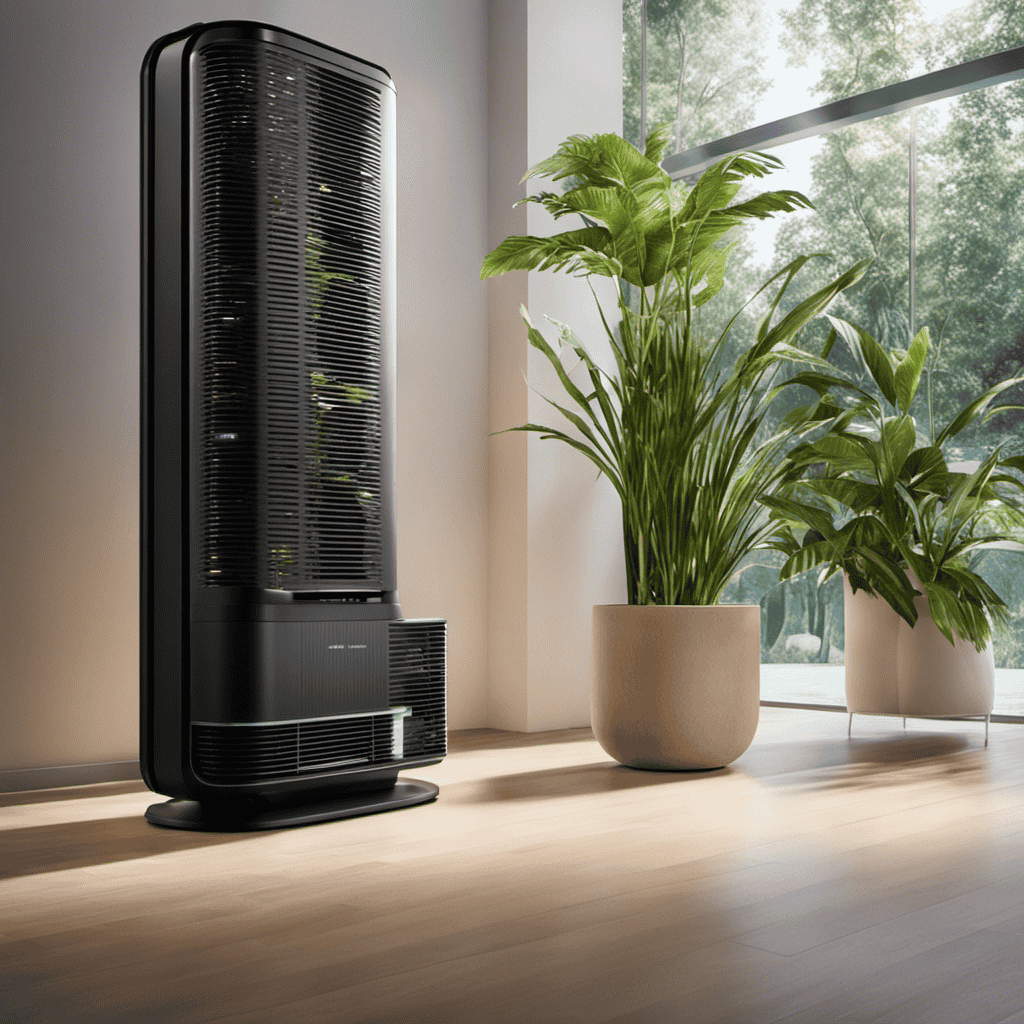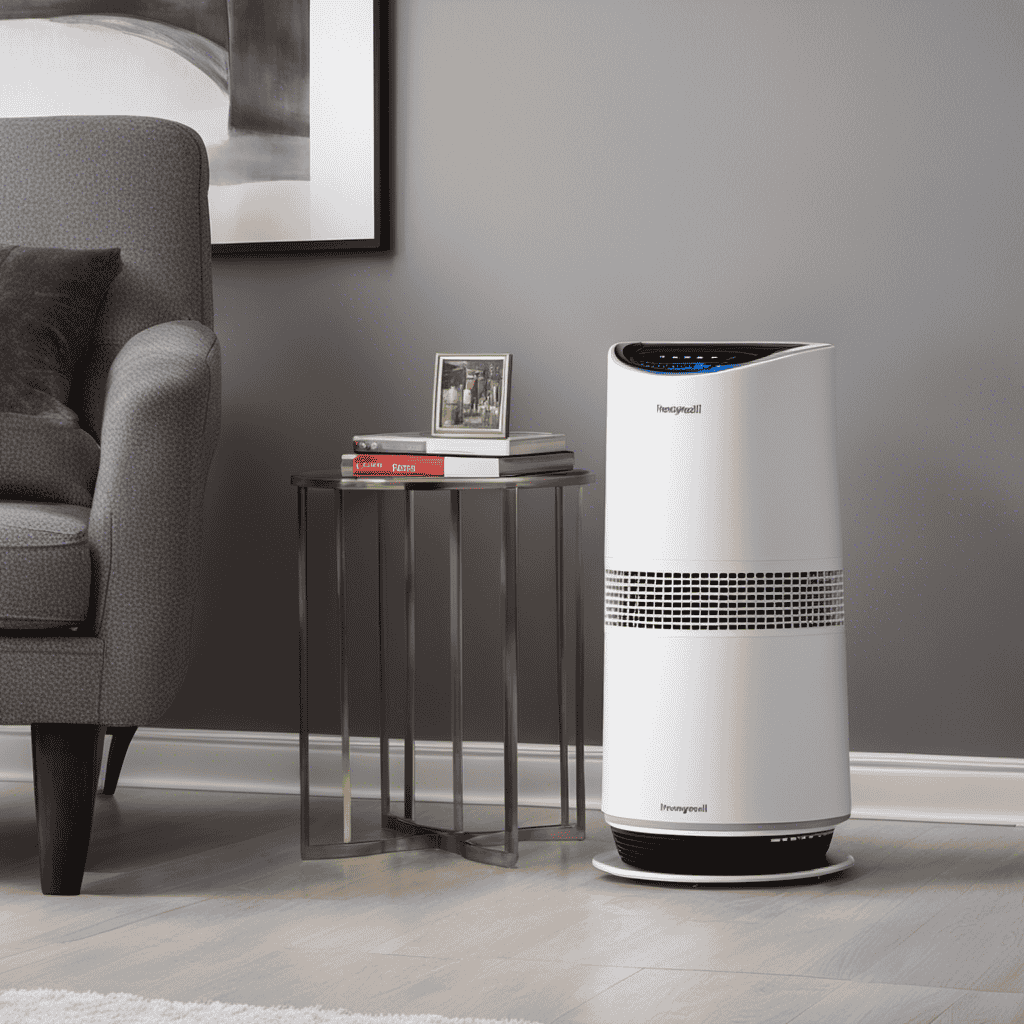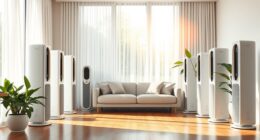Are you aware that the air indoors can be up to five times more polluted than the outdoor air? This is why air purifiers are gaining popularity.
In this article, I will explain how air purifiers work, the different types available, and the key features to look for when choosing one.
We will also discuss the importance of air purification and how it can improve the air quality in your home or office.
So let’s dive in and discover the science behind these powerful devices.
Key Takeaways
- Air purifiers use filters to trap and remove pollutants from the air.
- Different types of air purifiers utilize different technologies such as HEPA filters, activated carbon filters, and UV germicidal irradiation technology to clean the air.
- Air purifiers can effectively remove common allergens, pollutants harmful to respiratory health, and unpleasant odors.
- Factors to consider when choosing an air purifier include the type of filter used, the Clean Air Delivery Rate (CADR) rating, noise level, and the size of the room.
Types of Air Purifiers
There are several types of air purifiers available on the market. These devices are designed to improve indoor air quality by removing pollutants and allergens from the air. Air purifiers offer a range of benefits, including reducing allergy symptoms, eliminating odors, and improving respiratory health.
One common type of air purifier is the HEPA (High-Efficiency Particulate Air) filter. This technology uses a fibrous material to trap particles such as dust, pollen, pet dander, and mold spores. HEPA filters can capture particles as small as 0.3 microns, making them highly effective in removing allergens from the air.
Another type of air purifier is the activated carbon filter. These filters are effective at removing odors, smoke, and other volatile organic compounds (VOCs) from the air. Activated carbon works by adsorbing these pollutants, trapping them within its porous structure.
UV germicidal irradiation is a technology used in air purifiers to kill bacteria, viruses, and other microorganisms. This process involves exposing the air to ultraviolet (UV) light, which damages the DNA of these harmful organisms, rendering them unable to reproduce.
In conclusion, there are various types of air purifiers available, each utilizing different technologies to remove pollutants from the air. These devices offer numerous benefits, including improved respiratory health and a reduction in allergy symptoms.
Now, let’s explore the importance of air purification in more detail.
The Importance of Air Purification
When it comes to improving indoor air quality, air purifiers play a crucial role.
Not only do they help remove harmful pollutants and allergens from the air, but they also provide numerous health benefits.
Health Benefits of Purifiers
Using air purifiers can provide a range of health benefits. Air purifiers are particularly beneficial for individuals who suffer from allergies or respiratory conditions. Here are four ways in which air purifiers can promote better health:
-
Allergen Reduction: Air purifiers are designed to capture and remove common allergens, such as pollen, pet dander, and dust mites, from the air. This helps to alleviate allergy symptoms and provide relief.
-
Improved Air Quality: Air purifiers filter out pollutants and contaminants, such as smoke and volatile organic compounds (VOCs), which can be harmful to respiratory health. By removing these particles, air purifiers help to create a cleaner and healthier indoor environment.
-
Asthma Prevention: Air purifiers can help to reduce asthma triggers, such as dust and mold spores, by eliminating them from the air. This can help to prevent asthma attacks and improve overall respiratory health.
-
Odor Elimination: Air purifiers with activated carbon filters can effectively remove unpleasant odors from the air, such as those caused by cooking, pets, or chemicals. This helps to create a more pleasant and odor-free living space.
Indoor Air Quality Improvement
Indoor air quality can be significantly improved with the use of air purifiers. These devices are essential in addressing indoor air pollution, a major concern that can contain various common air contaminants. These contaminants include dust, pollen, pet dander, mold spores, and volatile organic compounds (VOCs). The presence of these pollutants can have adverse effects on our health, leading to allergies, respiratory problems, and even long-term health issues.
Air purifiers are effective because they work by filtering the air and trapping these contaminants. This process ensures that the air we breathe is clean and healthy. To achieve this, air purifiers use different types of filters, such as high-efficiency particulate air (HEPA) filters, activated carbon filters, and ultraviolet (UV) germicidal lights. These filters capture and eliminate pollutants, removing harmful particles from the air.
Understanding Air Quality
To understand air quality, you need to be aware of the pollutants present in your environment. Air pollutants can come from various sources, both indoor and outdoor. It is important to monitor air quality to ensure a healthy and safe living environment.
Here are some key points to help you understand air pollutants and air quality monitoring:
-
Types of Air Pollutants: Common air pollutants include particulate matter (PM), volatile organic compounds (VOCs), nitrogen oxides (NOx), and ozone (O3). These pollutants can have harmful effects on human health and the environment.
-
Sources of Air Pollutants: Air pollutants can originate from various sources such as vehicle emissions, industrial processes, burning of fossil fuels, and even everyday household activities like cooking and cleaning.
-
Health Effects: Exposure to high levels of air pollutants can lead to respiratory problems, allergies, asthma, and even cardiovascular diseases. It is important to minimize exposure to these pollutants to protect our health.
-
Air Quality Monitoring: Monitoring air quality involves measuring and analyzing the concentration of pollutants in the air. This can be done using specialized equipment and sensors that provide real-time data. Monitoring helps identify pollution sources, assess the effectiveness of control measures, and take necessary actions to improve air quality.
Components of an Air Purifier
When it comes to understanding air purifiers, it is important to delve into the key components that make them function effectively.
In this discussion, I will explain the different types of filters used in air purifiers, their respective purposes, and how they contribute to the purification process.
Additionally, I will break down the purification process itself, highlighting the steps involved and the role each component plays in ensuring clean and fresh air.
Lastly, I will explore the functions of key components in an air purifier, such as the fan, motor, and sensors, and how they work together to enhance the overall performance of the device.
Filter Types Explained
You’ll find that air purifiers use various filter types to remove different pollutants from the air in your home. Filter maintenance is an essential aspect of air purifier technology to ensure its effectiveness.
Here are the different filter types commonly used in air purifiers:
-
Pre-filter: This initial filter captures larger particles like dust and pet hair, extending the lifespan of the main filter.
-
HEPA filter: High-Efficiency Particulate Air filters trap 99.97% of particles as small as 0.3 microns, including allergens, pollen, and mold spores.
-
Activated carbon filter: This filter absorbs odors, gases, and volatile organic compounds (VOCs), leaving your home smelling fresh.
-
UV-C light filter: Ultraviolet light kills bacteria, viruses, and germs by damaging their DNA, providing an extra layer of purification.
By understanding the different filter types, you can choose the right air purifier for your needs and ensure proper filter maintenance.
Now, let’s delve into the purification process breakdown.
Purification Process Breakdown
To understand how air purifiers remove pollutants from the air in your home, let’s break down the purification process. Air purifiers use various technologies to capture and eliminate common air pollutants such as dust, pollen, pet dander, mold spores, and smoke particles. The purification process typically involves multiple stages, each targeting specific types of pollutants.
Here is a breakdown of the purification process:
| Stage | Technology Used | Targeted Pollutants |
|---|---|---|
| Pre-filter | Mesh or fabric filter | Large particles |
| HEPA filter | High-efficiency filter | Small particles |
| Activated carbon filter | Porous carbon material | Odors and gases |
The pre-filter captures larger particles like dust and pet hair, while the HEPA filter traps smaller particles like pollen and mold spores. The activated carbon filter then adsorbs odors and gases. Together, these filters effectively remove a wide range of pollutants, improving the air quality in your home.
Key Component Functions
The pre-filter captures larger particles, while the HEPA filter traps smaller particles, and the activated carbon filter adsorbs odors and gases. These three components work together to effectively purify the air in an air purifier.
Here is a component analysis of each mechanism:
-
Pre-filter: This component acts as the first line of defense by capturing larger particles such as dust, pet hair, and pollen. It prevents these particles from clogging the HEPA filter and prolongs its lifespan.
-
HEPA filter: This high-efficiency filter removes smaller particles like allergens, mold spores, and bacteria. It is capable of trapping particles as small as 0.3 microns, providing clean and healthy air.
-
Activated carbon filter: This filter is responsible for eliminating odors and gases. It contains activated carbon, which adsorbs and traps volatile organic compounds (VOCs), smoke, and unpleasant smells.
-
Additional features: Some air purifiers may also include ionizers or UV lights to further enhance the purification process by neutralizing airborne particles and killing viruses and bacteria.
Understanding the individual roles of these components is essential for effective air purification mechanisms.
How Air Purifiers Remove Pollutants
Air purifiers use filters to trap and remove pollutants from the air. In addition to filters, there are other methods employed by air purifiers to enhance their effectiveness. Two such methods are the use of negative ions and electrostatic precipitators.
Negative ions are molecules that have gained an extra electron, giving them a negative charge. Air purifiers can generate negative ions and release them into the air. When these negative ions come into contact with pollutants, such as dust or pollen, they attach to them. This causes the pollutants to become heavier and fall to the ground or onto surfaces, effectively removing them from the air.
Electrostatic precipitators are another technology used by some air purifiers. These devices work by charging the particles in the air and then collecting them on plates with an opposite charge. As the air passes through the purifier, the charged particles are attracted to the plates and stick to them. This process effectively removes the pollutants from the air.
Key Features to Look for in an Air Purifier
Now that we understand how air purifiers work and how they remove pollutants from the air, let’s explore some key features to look for in an air purifier.
These features are important for proper air purifier maintenance and take advantage of the latest air purifier technology advancements.
-
Filter Type: Look for an air purifier that uses a HEPA (High Efficiency Particulate Air) filter. HEPA filters can capture particles as small as 0.3 microns, including allergens, dust, pet dander, and pollen.
-
CADR Rating: Check the Clean Air Delivery Rate (CADR) rating, which indicates how quickly an air purifier can clean the air in a room. Look for higher CADR ratings for more efficient air cleaning.
-
Noise Level: Consider the noise level of the air purifier, especially if you plan to use it in a bedroom or office. Look for air purifiers with a low noise level, so it doesn’t disrupt your sleep or work.
-
Smart Features: Some air purifiers come with smart features like Wi-Fi connectivity and smartphone apps. These features allow you to monitor and control the air purifier remotely, making it convenient and easy to use.
By considering these key features, you can ensure that you choose an air purifier that is effective, efficient, and suits your specific needs.
And now, let’s transition into the next section where we will discuss how to choose the right size air purifier for your space.
Choosing the Right Size Air Purifier for Your Space
When choosing the right size air purifier for your space, it’s important to consider the square footage of the room. Air purifiers come in various sizes, and selecting the appropriate size is crucial for optimal performance.
To determine the ideal air purifier size for your room, you need to calculate the room size. This can be done by measuring the length and width of the room and multiplying them together to obtain the square footage. Once you have the square footage, you can refer to the manufacturer’s recommendations to find the recommended air purifier size for that room size.
Considerations for air purifier size go beyond just the square footage of the room. Other factors that may affect the size selection include the height of the ceiling, the number of occupants in the room, and the level of air pollution. If you have a high ceiling or a room with multiple occupants, you may need a larger air purifier to adequately clean the air. Similarly, if the room is heavily contaminated or prone to allergens, a larger air purifier with a higher clean air delivery rate (CADR) may be necessary.
It is important to note that selecting an air purifier that is too small for your space will result in inadequate air purification. Conversely, choosing an air purifier that is too large may lead to unnecessary energy consumption and higher costs. By considering the square footage, ceiling height, occupants, and air pollution level, you can ensure that you choose the right size air purifier for your space, providing you with cleaner and healthier air.
Maintaining and Cleaning Your Air Purifier
To keep your air purifier running efficiently, it’s important to regularly clean and maintain it according to the manufacturer’s instructions. Here are some key steps to follow in order to properly maintain and clean your air purifier:
-
Replace the filters: Air purifiers typically have filters that need to be replaced regularly. This is important because over time, the filters can become clogged with dust, allergens, and other particles, which can reduce the effectiveness of the purifier. Follow the manufacturer’s recommendations for filter replacement intervals.
-
Clean the exterior: Dust and dirt can accumulate on the exterior of your air purifier, so it’s important to give it a regular wipe down. Use a soft cloth and mild detergent to clean the surface. Avoid using harsh chemicals or abrasive materials, as they can damage the purifier.
-
Check the fan and vents: The fan and vents of your air purifier can also collect dust and debris. Periodically, check these areas and gently clean them using a soft brush or vacuum attachment.
-
Keep the area around the purifier clean: To maximize the efficiency of your air purifier, it’s important to maintain a clean environment. Regularly vacuum and dust the room to prevent dirt and dust from accumulating and being circulated by the purifier.
Benefits of Using an Air Purifier in Your Home or Office
If you want to improve the air quality in your home or office, using an air purifier can provide numerous benefits. Air purifiers are designed to remove harmful pollutants and allergens from the air, helping to create a healthier and cleaner environment.
Compared to natural methods, such as opening windows or using plants, air purifiers are more effective at capturing and eliminating airborne particles.
One of the key advantages of using an air purifier is its ability to remove a wide range of pollutants, including dust, pollen, pet dander, mold spores, and even volatile organic compounds (VOCs) emitted by cleaning products and furniture. These pollutants can have negative effects on our respiratory system and overall well-being, so having an air purifier can help alleviate these issues.
When it comes to cost-effective options, there are plenty of affordable air purifiers available in the market. These options may not have all the bells and whistles of high-end models, but they can still effectively clean the air in your space. Look for air purifiers with HEPA filters, as these are known to be highly efficient in capturing airborne particles.
Frequently Asked Questions
Can Air Purifiers Remove All Types of Pollutants From the Air?
Yes, air purifiers can remove many types of pollutants from the air. They are effective in reducing common indoor air pollutants such as dust, pollen, pet dander, and mold spores.
However, it’s important to note that not all air purifiers can capture all types of pollutants. Some models are specifically designed to target certain pollutants like smoke or volatile organic compounds (VOCs).
It’s crucial to choose an air purifier that is suitable for your specific needs and the types of pollutants you want to remove.
Are Air Purifiers Effective in Reducing Allergies and Asthma Symptoms?
Air purifiers have been a game-changer for my allergies and asthma symptoms. It’s like having a superhero in my home, fighting off all the pesky allergens and pollutants in the air.
These purifiers are incredibly effective in improving indoor air quality and reducing the triggers that can worsen allergies and asthma.
When comparing different air purifiers, it’s important to look for features like HEPA filters and activated charcoal. These features can help capture and eliminate the allergens and irritants that cause respiratory issues.
How Often Should I Replace the Filters in My Air Purifier?
When it comes to air purifier maintenance, it’s important to consider the lifespan of the filters. The frequency of filter replacement depends on various factors, such as the type of air purifier and the quality of the filters.
Generally, it is recommended to replace the filters every 6 to 12 months. However, some filters may need to be replaced more frequently, especially if the air quality in your environment is poor.
Regularly replacing the filters ensures that your air purifier continues to effectively remove pollutants from the air.
Can Air Purifiers Remove Odors From the Air?
Yes, air purifiers can remove odors from the air. They use filters to capture and trap particles and pollutants, including odor-causing molecules.
Regular air purifier maintenance, such as replacing filters, is crucial to ensure optimal performance.
By effectively removing odors, air purifiers can improve indoor air quality and create a more pleasant and fresh-smelling environment.
The benefits of using air purifiers extend beyond odor removal, as they can also help reduce allergens, dust, and other harmful pollutants in the air.
Do Air Purifiers Produce Any Harmful Byproducts or Ozone?
Air purifier safety is an important aspect to consider when using these devices. One concern is the potential emission of ozone, which can be harmful to our health. It is crucial to choose air purifiers that are certified as ozone-free or have low ozone emission levels.
These devices typically use filters or other technologies to remove pollutants from the air without producing harmful byproducts. Ensuring the safety of air purifiers is essential for maintaining good indoor air quality.
Conclusion
In conclusion, air purifiers are a valuable tool in improving indoor air quality and promoting a healthier environment.
With various types and key features to consider, it is essential to choose the right size air purifier for your space.
Regular maintenance and cleaning will ensure optimal performance.
Remember, ‘clean air is a fundamental right, not a luxury.’
So, invest in an air purifier and enjoy the numerous benefits it brings to your home or office.
Breathe easy and live better with an air purifier by your side.










